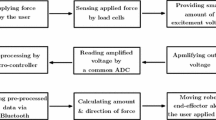Abstract
During some key force measuring tasks in the harsh environment such as aerospace, national defense, deep-sea exploration, higher working reliability is required. The design concept of fault-tolerance is proposed in the design of parallel six-component force sensor. Two kinds of fault-tolerant parallel structure force sensor without pre-stressing platform and two kinds of fault-tolerant and fully pre-stressed parallel structure force sensor using modified spherical pairs, together with another three kinds of wheel-spoke fault-tolerant force sensor are proposed. Compared with traditional Stewart platform-based sensor, the structural characteristics of the sensors are analyzed. The complete mathematic models including the models before and after signal fault are established by using theory of screw and the relations between stiffness and force distribution. The unified mathematic model is suitable for all the fault-tolerant six-component force sensor with different structures proposed in this paper. Calibration study of a sensor prototype without fault and with signal fault is carried out and non-linear errors are analyzed. The research of the paper provides not only theoretical basis and practical significance for the study on high reliable six-component force sensor, but also a new applied orientation for the redundant parallel mechanism.











Similar content being viewed by others
References
Cho HS, Warnecke HJ, Gweon DG (1987) Robotic assembly: a synthesizing overview. Robotica 5:153–165
Qiao H, Dalay BS, Parkin RM (1993) Robotic peg-hole insertion operations using a six-component force sensor. Proc Inst Mech Eng Part C J Mech Eng Sci 207:289
Park JJ, Kim GS (2005) Development of the 6-axis force/moment sensor for an intelligent robot’s gripper. Sens Actuators A 118:127–134
Kim GS, Shin HJ, Yoon J (2008) Development of 6-axis force/moment sensor for a humanoid robot’s intelligent foot. Sens Actuators A 141:276–281
Gobbi M, Mastinu Pennati M (2008) Indoor testing of road vehicle suspensions. Meccanica 43:173–184
Wright AM, Wright AB, Born T, Strickland R (2013) A six degree-of-freedom thrust sensor for a labscale hybrid rocket. Meas Sci Technol 24:125104
Merlet JP (2006) Parallel robots (Second Edition II). Springer, Berlin, pp 265–266
Gaillet A, Reboulet C (1983) An isostatic six component force and torque sensor. In: Proceedings of the 13th international symposium on industrial robots 1(11):25–28
Kerr DR (1989) Analysis, properties and design of a Stewart-platform transducer. Mech Transm Autom Des 1(11):25–28
Dwarakanath TA, Dasgupta B, Mruthyunjaya TS (2001) Design and development of a Stewart platform based force–torque sensor. Mechatronics 11(7):793–809
Gao F, Zhang JJ, Chen YL, Jin ZL (2003) Development of a new type of 6-DOF parallel micro-manipulator and its control system. In: Proceedings of the IEEE, international conference on robotics, intelligent system and signal processing, Changsha, China, pp 715–720
Nguyen CC, Antrazi SS, Zhou ZL (1991) Analysis and implementation of a 6-dof Stewart platform-based force sensor for passive compliant robotic assembly. Proc IEEE SOUTHEASTCON 2:880–884
Jin ZL, Gao F, Zhang XH (2003) Design and analysis of a novel isotropic six-component force/torque sensor. Sens Actuators A 109:17–20
Bandyopadhyay S, Ashitava G (2008) An algebraic formulation of kinematic isotropy and design of isotropic 6-6 Stewart platform manipulators. Mech Mach Theory 43(5):591–616
Hou YL, Yao JT, Lu L, Zhao YS (2009) Performance analysis and comprehensive index optimization of a new configuration of Stewart six-component force sensor. Mech Mach Theory 44(2):359–368
Yao JT, Hou YL, Wang H et al (2011) Spatially isotropic configuration of Stewart platform-based force sensor. Mech Mach Theory 46:142–155
Li J, Li JF, Wu Z, Zhang QX (2002) Fault tolerance of redundant manipulators when multi-joint failed and its optimization. Chin J Mech Eng 38(7):111–115 (in Chinese)
Yi Y, McInroy JE, Chen YX (2006) Fault tolerance of parallel manipulators using task space and kinematic redundancy. IEEE Trans Rob 22(5):1017–1021
Roberts RG, Maciejewski AA (1996) A local measure of fault tolerance for kinematically redundant manipulators. IEEE Trans Robot Autom 12(4):543–552
Pennock GR, Squires CC (1998) Velocity analysis of two 3-R robots manipulating a disk. Mech Mach Theory 33(12):71–86
Zhao J, Zhang KL, Yao XB (2005) Study on fault tolerant workspace and fault tolerant planning algorithm based on optimal initial position for two spatial coordinating manipulators. Mech Mach Theory 41(5):584–595
Yao JT, Zhu JL, Wang ZJ et al (2013) Measurement theory and experimental study of fault-tolerant fully pre-stressed parallel six-component force sensor. IEEE Sens J 13(9): 3472–3482
Acknowledgments
This research is sponsored by the financial support of the Major State Basic Research Development Program of China (973 Program) (Grant No. 2013CB733000), the NSFC(Grant Nos. 51305383, 51275439), and Specialized Research Fund for the Doctoral Program of Higher Education (SRFDP) (20131333120007), Hebei Province Natural Science Research Project for Distinguished Young Scholars in Higher Education Institutions (No. YQ2014040). The reviewers are also acknowledged for their critical comments.
Author information
Authors and Affiliations
Corresponding authors
Rights and permissions
About this article
Cite this article
Yao, J., Zhang, H., Zhang, W. et al. Fault-tolerant parallel six-component force sensor. Meccanica 51, 1639–1651 (2016). https://doi.org/10.1007/s11012-015-0299-5
Received:
Accepted:
Published:
Issue Date:
DOI: https://doi.org/10.1007/s11012-015-0299-5




